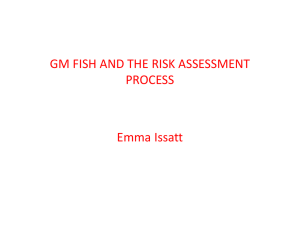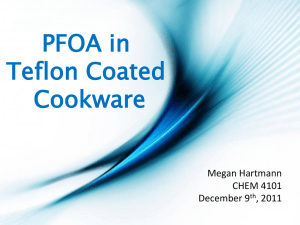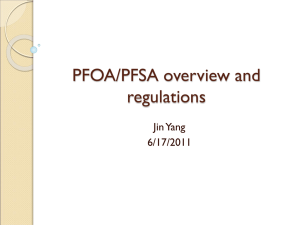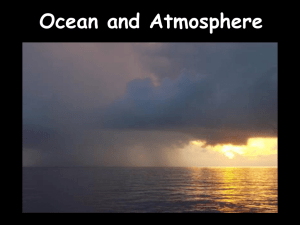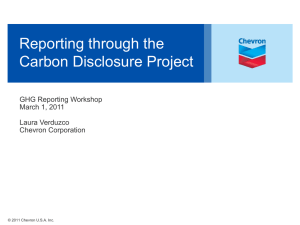Metoder i moderne kemi, 2000
advertisement
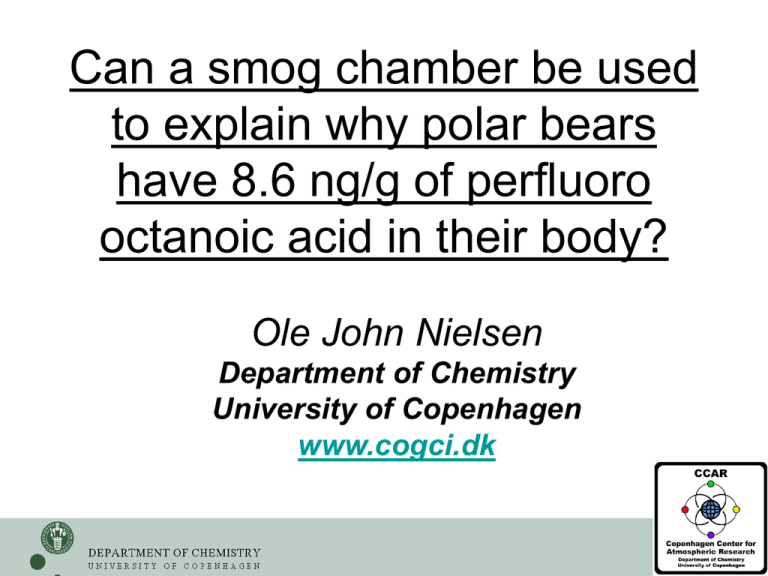
Can a smog chamber be used to explain why polar bears have 8.6 ng/g of perfluoro octanoic acid in their body? Ole John Nielsen Department of Chemistry University of Copenhagen www.cogci.dk 1 Acknowledgements Mads P. S. Andersen JPL-NASA, Pasadena, CA, USA Tim. J. Wallington, Mike. P. Hurley, Jim. C. Ball Ford Motor Company, Dearborn, MI, USA Scott. A. Mabury University of Toronto, Toronto, ON, Canada 2 Why am I here? 3 Outline 1. Who am I? 2. Why the interest in PerFluoro Organic Acids (PFOAs) and FluoroTelomer alcohols (FTOHs)? 3. What are PFOA, PFCA and PFOA again? 4. Use of FTOH = CnF2n+1CH2CH2OH (straight chain) 5. Atmospheric chemistry of FTOHs 6. Environmental Impacts and Conclusions 7. Discussions 4 Who am I? 1954 Born 1973 Began at UoC (chemistry and physics) 1974 Important Atmospheric Year 1978 M.Sc. and on to do a PhD at Risø Nat. Lab. 1978-95 Risø National Laboratory 1995-96 Ford Research Center Aachen, Germany 1996-99 Risø National Laboratory 1999-? Professor at UoC 2007 Nobel Peace Prize together with Al Gore and 2500 scientists Gas phase kinetics and reaction mechanisms - relevant to the atmosphere – How? Why? IPCC – Intergovernmental Panel of Climate Change 5 2. Why the interest in PerFluoro Organic Acids (PFOAs) and FluoroTelomer alcohols (FTOHs)? • What do you think? • The interest in environmental chemistry is driven by? • Health Concerns 6 Contact Us | Print Version Perfluorooctanoic Acid (PFOA) and Fluorinated Telomers January 12, 2005: Draft PFOA Risk Assessment submitted to EPA Science Advisory Board for Peer Review: SAB meeting February 22-23, 2005. PFOA stands for perfluorooctanoic acid, a synthetic (man-made) chemical that does not occur naturally in the environment. PFOA is sometimes called "C8." Companies use PFOA to make fluoropolymers, substances with special properties that have thousands of important manufacturing and industrial applications. Consumer products made with fluoropolymers include non-stick cookware and breathable, all-weather clothing. More BASIC INFORMATION about PFOA. EPA began its investigation because PFOA is very persistent in the environment, was being found at very low levels both in the environment and in the blood of the general U.S. population, and caused developmental and other adverse effects in laboratory animals. EPA summarized its concerns and identified data gaps and uncertainties about PFOA in a notice published in the Federal Register. 7 Risk Assessment You will need Adobe Reader to view some of the files on this page. See EPA's PDF page to learn more. In January 2005, the EPA Office of Pollution Prevention and Toxics submitted a Draft Risk Assessment of the Potential Human Health Effects Associated With Exposure to Perfluorooctanoic Acid and Its Salts (PFOA) (PDF) (132pp, 450KB) to the EPA Science Advisory Board (SAB) for formal peer review. EPA sought this early stage scientific peer review from an outside panel of experts in order to ensure the most rigorous science is used in the Agency's ongoing evaluation of PFOA. That draft was preliminary and did not provide conclusions regarding potential levels of concern. The SAB reviewed the information that was available at the time, and suggested that the PFOA cancer data are consistent with the EPA Guidelines for Carcinogen Risk Assessment descriptor "likely to be carcinogenic to humans." Since its review, additional research has been conducted pertaining to the carcinogenicity of PFOA. EPA is still in the process of evaluating this information and has not made any definitive conclusions regarding potential risks, including cancer, at this time. More information can be found on the SAB PFOA Review Panel Website. EPA is not waiting for all of the answers to be known before taking action, however. In January 2006, EPA asked eight companies in the industry to commit to reducing PFOA from facility emissions and product content by 95 percent no later than 2010, and to work toward eliminating PFOA from emissions and product content no later than 2015. All eight 8 of the invited companies submitted commitments to the Stewardship Program by March 1, 2006. Read more information on the PFOA 2010/15 Stewardship Program. In 2006, former Administrator Stephen L. Johnson invited the eight major fluoropolymer and telomer manufacturers to join in a global stewardship program with two goals: To commit to achieve, no later than 2010, a 95% reduction, measured from a year 2000 baseline, in both facility emissions to all media of PFOA, precursor chemicals that can break down to PFOA, and related higher homologue chemicals, and product content levels of these chemicals. To commit to working toward the elimination of these chemicals from emissions and products by 2015. Participating companies include: Arkema, Asahi, Ciba, Clariant, Daikin, 3M, DuPont, Solvay Solexis Submitted baseline year 2000 data on emissions and product content at the end of October 2006. Report annual progress toward goals each succeeding October and report progress in terms of both U.S. and global operations. Companies also agreed to work cooperatively with EPA and establish scientifically credible analytical standards and laboratory methods to ensure comparability of reporting 9 3. What are PFOAs, PFCAs and PFOA? PerFluorinated Organic Acids PerFluorinated Carboxylic Acids PerFluorinated Octanoic Acid HO F C F F C O F F F F F F F F F F F F F F F F F F F F F F Long chain perfluorinated acids (PFCAs/PFAs) observed in fauna in urban and remote locations PFOA (perfluorooctanoic acid) C7F15C(O)OH PFNA (perfluorononanoic acid) C8F17C(O)OH PFDA (perfluorodecanoic acid) C9F19C(O)OH PFUA (perfluoroundecanoic acid) C10F21C(O)OH F F F F PFPeA 10 11 In the far north... …in Polar Bears? HO PFACsng/g PFOA (8) PFNA (9) PFDA (10) PFUNA (11) PFDoA (12) PFTrA (13) PFTA (14) PFPeA (15) 8.6 180 56 63 6.2 11 0.51 <0.5 F C F F C O F F F F F F F F F F F F F F F F F F F F F F F F F F PFPeA Martin et al., EST 38 (2004) 373. 12 Facts: No natural sources. Water-soluble PFCA salts used in fluoropolymer processing. Not released in major quantities. Presence of PFCAs in remote areas suggests atmospheric source. The science (why) question? Why are they here? Where do long chain Perfluorocarboxylicacids (PFCAs), CnF2n+1COOH come from? Our hypothesis: They are atmospheric degradation products from other long chain fluorinated compounds emitted to the atmosphere 13 “Airport Foam Seeps into Creek” Toronto Star, June 10, 2000 22,000 liters of AFFF; ~300 kg of PFOS! 14 Etobicoke Creek Fish Liver Samples; Jan 5, 2001 (spill + 7 months) JAN17-ETOBCREEK-DOWNSTREAM F F F F F F F F F F F F F F HO % F F F F F F F F F F F F F C O MRM of 12 Channels ES713 > 669 1.46e3 PFTA 100 0 JAN17-ETOBCREEK-DOWNSTREAM MRM of 12 Channels ES613 > 569 4.46e3 PFDoA 100 % 0 JAN17-ETOBCREEK-DOWNSTREAM MRM of 12 Channels ES563 > 519 1.82e3 PFUnA 100 % 0 JAN17-ETOBCREEK-DOWNSTREAM MRM of 12 Channels ES513 > 469 3.03e3 PFDA 100 % 0 JAN17-ETOBCREEK-DOWNSTREAM PFOS 100 % 0 JAN17-ETOBCREEK-DOWNSTREAM PFOA 100 % 0 JAN17-ETOBCREEK-DOWNSTREAM 100 % 0 JAN17-ETOBCREEK-DOWNSTREAM 100 % 0 10.00 10.50 11.00 11.50 MRM of 12 Channels ES499 > 99 2.52e5 MRM of 12 Channels ES413 > 369 1.06e3 PFHxS MRM of 12 Channels ES399 > 99 2.18e3 PFHpA MRM of 12 Channels ES363 > 319 1.06e3 12.00 12.50 13.00 13.50 C14 C12 C11 C10 C8S C8 C6S C7 Time 14.00 Moody, C.A., W.C. Kwan, J.W. Martin, D.C.G. Muir, and S.A. Mabury. 2001. Determination of Perfluorinated Surfactants in Surface Water Samples by Two Independent Analytical Techniques – Liquid Chromatography/Tandem Mass Spectrometry and 19F NMR. Analytical Chemistry. 73:2200-2206. 15 Moody, C.A., J. W. Martin, W. C. Kwan, D. C. G. Muir, and S. A. Mabury. 2002. Monitoring Perfluorinated Surfactants in Biota and Surface Water Samples Following an Accidental Fire-Fighting Foam Release into Etobicoke Creek. Environ. Sci. Technol. 36:545-551. 4. FTOH = fluorotelomer alcohol 2001 – FTOHs observed in atmosphere. Oxidation of FTOHs could be a source of PFCA source (against conventional wisdom in atmospheric chemistry community). CnF2n+1CH2CH2OH (straight chain) 4:2 FTOH = C4F9CH2CH2OH 6:2 FTOH = C6F13CH2CH2OH 8:2 FTOH = C8F17CH2CH2OH 10:2 FTOH = C10F21CH2CH2OH 16 PolyfluoroAlcohols are highly volatile!!! 10000 Log P (Pascals) 1000 100 10 1 .1 .01 50 H H O 8:2 FTOH = 212 Pa C H F C H FF H F F Fluorotelomer Alcohols F F F F F F F F F F Hydrocarbon Alcohols F F 150 250 350 450 550 Molecular Mass HC data from Daubert & Danner; FTOH data from Lei et al, submitted J Chem Eng Data and Stock et al, ES&T in press. 17 FTOH based coatings heavily used in consumer products; F Potential Sources? 5x106 kg/yr 40% in North America 80% are in polymers* F F F F F F F H H C OH C F F F F F F F F F H H Residual F F F F F F F F F F F F F F F F F F F F F F F F F F F CH2 F H2C O O O C O N Ester Urethane F F F F F F F F F F F F F F CH2 H 2C F F F F F F F F F F F F F CH2 H 2C F F Degradation F F F Carpet Treatment F F F F F F F CH2 H2C OH O Ether Polymer *TRP Presentation to USEPA OPPT. Nov 25, 2002 US Public Docket AR226-1141 F 18 Research Question: Does atmospheric oxidation of FTOHs contribute significantly to PFCA burden in remote locations? Three necessary conditions: (1) FTOH survive atmospheric transport (2) FTOH degrade to give PFCAs (3) Magnitude of PFCA formation must be significant Use a FTIR Smog chamber 19 20 4. Experimental apparatus and setup FTIR SMOG CHAMBER o 140 L Pyrex chamber o X/Cl2/N2/O2/black-lamps o X/CH3ONO/NO/air/black-lamps 296 K, 700 Torr 21 22 23 24 Does atmospheric oxidation of FTOHs contribute significantly to PFCA burden in remote locations? Three necessary conditions: (1) Do FTOHs survive atmospheric transport? Measurement of k(OH+FTOH) – Why? (2) Do FTOHs degrade to give PFCAs? (3) Magnitude of PFCA formation must be significant? 25 UV irradiation of FTOH/reference/CH3ONO/NO/air mixtures FTOH = 4:2 FTOH, 6:2 FTOH, or 8:2 FTOH reference = C2H2 or C2H4 CH3ONO CH3O + NO CH3O + O2 HCHO + HO2 HO2 + NO OH + NO2 OH + FTOH products (1) OH + reference products (2) 26 OH + FTOH products (1) OH + reference products (2) d [FTOH] k1[OH ]ss[FTOH] dt d [reference ] k2[OH] ss [reference ] dt Integration gives: [FT OH]to k1[OH]ss t Ln [FT OH]t [reference]to k2[OH]ss t Ln [reference]t FTOH and reference have equal exposure to OH radicals, hence: [FT OH]to k1 [reference ]to Ln Ln ]t [FT OH]t k2 [reference 27 Ln([F(CF2CF2)n(CH2)2OH]to/[F(CF2CF2)n(CH2)2OH]t) 0.6 C2H2 0.5 0.4 No discernable difference in reactivity of OH radicals towards 4:2, 6:2, and 8:2 FTOH 0.3 0.2 C2H4 0.1 0.0 0.0 0.5 1.0 1.5 Ln ([Reference]to/[Reference]t) Loss of FTOH (squares = 4:2; circles = 6:2; triangles = 8:2) versus C2H2 and C2H4 on exposure to OH radicals in 700 Torr of air diluent at 296 K. 28 Ln([F(CF2CF2)n(CH2)2OH]to/[F(CF2CF2)n(CH2)2OH]t) 0.6 C2H2 0.5 0.4 0.3 0.2 C2H4 0.1 0.0 0.0 0.5 1.0 Ln ([Reference]to/[Reference]t) 1.5 OH + CnF2n+1CH2CH2OH → products (10) OH + C2H2 → products (11) OH + C2H4 → products (12) Linear fits give k10/k11 = 1.18±0.15 and k10/k12 = 0.131±0.018. Using k11 = 8.5 x 10-13 and k12 = 8.66 x 10-12 gives k10 = (1.00±0.13) x 10-12 and (1.13±0.16) x 10-12 cm3 molecule-1 s-1. Final value, k10 = (1.07±0.22) x 10-12 cm3 molecule-1 s-1. 29 FTOH Lifetime Estimate Assuming: atmospheric lifetime* for CH3CCl3 = 5.7 years k(CH3CCl3 + OH) = 1.0 x 10-14 cm3 molecule-1 s-1 then atmospheric lifetime* of F(CF2)nCH2CH2OH (1.0x10-14)/(1.1x10-12) x 5.7 x 365 20 days. * with respect to reaction with OH radicals 30 Other loss mechanisms? Photolysis – should be negligible Rainout – estimated to be negligible Dry deposition – lifetime estimated to be 8 years Homogeneous reactions other than with OH - unlikely Atmospheric lifetime determined by reaction with OH and is approximately 20 days. 31 Ramifications of Lifetime (1) Estimate flux of 100-1000 t yr-1 necessary to sustain observed atmospheric concentration. (2) FTOH have negligible GWP (3) Spatial distribution will be inhomogeneous (4) FTOH will be transported to remote locations. Global average wind speed = 5 m s-1, 20 days = 8500 km. 32 20 days… Long Enough for Long Range Transport? Assuming 5m/s winds and a 20d lifetime, FTOHs could be transported over 8500 km Copenhagen to Detroit = 6500 km 33 Does atmospheric oxidation of FTOHs contribute significantly to PFCA burden in remote locations? Three necessary conditions: (1) Do FTOHs survive atmospheric transport? YES (2) Do FTOHs degrade to give PFCAs? (3) Magnitude of PFCA formation must be significant 34 (A) before irradiation 0.25 0.20 0.15 FTIR study of 4:2 FTOH oxidation 0.10 0.05 0.00 0.25 CF3(CF2)3CH2CHO 0.20 is the major primary 0.10 atom and OH radical initiated 0.15 IR Absorbance product from Cl (B) 10 sec irradiation 0.05 0.00 0.08 (C) Product 0.06 0.04 0.02 oxidation of 4:2 FTOH 0.00 (D) CF3(CF2)3CH2CHO 0.15 0.10 0.05 0.00 35 700 900 1100 1300 1500 -1 1700 1900 FTOH Oxidation mechanism CnF2n+1CH2CH2OH + OH CnF2n+1CH2C(•)HOH + H2O CnF2n+1CH2C(•)HOH + O2 CnF2n+1CH2CHO + HO2 36 CnF2n+1CH2CHO is reactive … Gives secondary products … [CF3(CF2)3CH2CHO] / [CF3(CF2)3CH2CH2OH]0 0.5 0.4 0.3 0.2 0.1 0.0 0.0 0.2 0.4 0.6 0.8 1.0 [CF3(CF2)3CH2CH2OH] / [CF3(CF2)3CH2CH2OH]0 37 0.25 0.4 0.20 CF3(CF2)3CHO 0.3 0.15 CF3(CF2)3CH2COOH 0.2 0.10 0.1 0.05 UNKNOWN 0.0 [UNKNOWN] / [CF3(CF2)3CH2CH2OH]0 [products] / [CF3(CF2)3CH2CH2OH]0 0.5 Secondary products: CF3(CF2)3CHO, CF3(CF2)3CH2COOH, CF3(CF2)3C(O)OOH 0.00 0.0 0.2 0.4 0.6 0.8 1.0 [CF3(CF2)3CH2CHO] / [CF3(CF2)3CH2CH2OH]0 38 FTOH Oxidation mechanism CnF2n+1CH2CH2OH + OH CnF2n+1CH2C(•)HOH + H2O CnF2n+1CH2C(•)HOH + O2 CnF2n+1CH2CHO + HO2 CnF2n+1CH2CHO + OH + O2 CnF2n+1CH2C(O)OO + H2O CnF2n+1CH2C(O)OO + NO CnF2n+1CH2C(O)O + NO2 CnF2n+1CH2C(O)O CnF2n+1CH2 + CO2 CnF2n+1CH2 + O2 CnF2n+1CH2O2 CnF2n+1CH2O2 + NO CnF2n+1CH2O + NO2 CnF2n+1CH2O + O2 CnF2n+1CHO + HO2 39 0.25 0.4 0.20 CF3(CF2)3CHO 0.3 0.15 CF3(CF2)3CH2COOH 0.2 0.10 0.1 0.05 UNKNOWN 0.0 [UNKNOWN] / [CF3(CF2)3CH2CH2OH]0 [products] / [CF3(CF2)3CH2CH2OH]0 0.5 Secondary products: C4F 9CHO, C4F9CH2COOH C4F9C(O)OOH Secondary products are reactive … 0.00 0.0 0.2 0.4 0.6 0.8 1.0 [CF3(CF2)3CH2CHO] / [CF3(CF2)3CH2CH2OH]0 40 0.60 Tertiary products include: 0.50 (A) before irradiation 0.40 0.30 0.20 COF2, CF3OH 0.10 C4F9COOH 0.80 0.00 (B) 8.5 minutes irradiation 0.60 Conclusion of FTIR experiments: simulated atmospheric oxidation of 4:2 FTOH (in absence of NOx) gives a small (few %) yield of C4F9COOH IR Absorbance 0.40 0.20 0.00 0.08 (C) residual 0.06 0.04 0.02 0.00 0.30 (D) CF3(CF2)3COOH 0.20 0.10 0.00 1400 1600 1800 3500 -1 Wavenumber (cm ) 41 FTIR data shows that in gas phase: in absence of NOx 4:2 FTOH C4F9CHO C4F9COOH in presence of NOx 4:2 FTOH C4F9CHO C4F9COOH Likely explanation, presence of HO2 radicals in absence of NOx Well established that CH3C(O)O2 + HO2 gives acetic acid and peracetic acid, ,presumably CxF2x+1C(O)O2 + HO2 reaction gives CxF2x+1COOH and CxF2x+1COOOH. Product study of CxF2x+1C(O)O2 + HO2 (x=1-4) to test this idea. 42 Method CnF2n+1C(O)O2 and HO2 radicals generated by UV irradiation of CnF2n+1CHO/H2/Cl2 mixtures in 100-700 Torr of air at 296±2 K: Cl2 + h 2Cl Cl + CnF2n+1CHO CnF2n+1CO + HCl CnF2n+1CO + O2 + M CnF2n+1C(O)O2 + M Cl + H2 H + HCl H + O2 + M HO2 + M CnF2n+1C(O)O2 + HO2 products CnF2n+1C(O)O2 + CnF2n+2C(O)O2 products As [H2]o/CnF2n+1CHO]o , products/products , 43 0.5 0.4 Absorbance10 0.3 A: Before UV 0.2 0.1 0.0 0.4 0.10 0.3 B: After UV 0.2 0.05 0.1 0.00 0.0 C: C2F5C(O)OH E: CF3OH D: COF2 1700 1800 IR spectra obtained before (A) and after (B) 55 s of irradiation of a mixture of 18.8 mTorr C2F5C(O)H, 218 mTorr Cl2 and 2.8 Torr H2 in 700 Torr of air. The consumption of C2F5C(O)H was 63%. 1900 2000 3500 3600 3700 -1 Wavenumber (cm ) 44 PFCAs are products of CxF2x+1C(O)O2 + HO2 reaction Offers reasonable explanation of observed PFCA formation in 4:2 FTOH expts. 45 Branching ratios in reactions of RC(O)O2 with HO2 radicals under ambient conditions (700-760 Torr, 2962K). RC(O)O2 Reference Products RC(O)OOH+O2 RC(O)OH+O3 RC(O)O+O2+OH CH3C(O)O2 0.40 0.16 0.20 0.08 0.40 0.16 [21] CF3C(O)O2 0.09 0.04 0.38 0.04 0.56 0.05 This work C2F5C(O)O2 < 0.06 0.24 0.04 0.76 0.04 [27] C3F7C(O)O2 < 0.03 0.10 0.02 0.90 This work C4F9C(O)O2 < 0.03 0.08 0.02 0.90 This work 46 O O O + CF3 HO2 CF2 O CF2 O CF3 a O H O CF2 O O H b H CF3 O O O C2F5C(O)OOH + O 2 O O O c O O O CF3 CF2 O CF3 CF2 O O O H O C2F5C(O)OH + O 3 C2F5C(O)O + O 2 + OH 47 48 Does atmospheric oxidation of FTOHs contribute significantly to PFCA burden in remote locations? Three necessary conditions: (1) Do FTOHs survive atmospheric transport? YES (2) Do FTOHs degrade to give PFCAs? YES (3) Magnitude of PFCA formation must be significant 49 FTOH flux into Northern Hemisphere = 100-1000 t yr-1 Assume molar PFCA yield from FTOH of 1-10% Hence, PFCA flux = 1-100 t yr-1 Assume even spatial distribution Hence, PFCA flux to Arctic = 0.1 - 10 t yr-1 Persistent organochlorine pesticides arctic loading =1.8 t yr-1 Organochlorine pesticides detectable in polar bears at a similar concentration to PFCAs ( 100-1000 ng/g) Order of magnitude calculations suggest atmospheric oxidation of FTOHs is plausible explanation of PFCAs in remote areas. 50 Does atmospheric oxidation of FTOHs contribute significantly to PFCA burden in remote locations? Three necessary conditions: (1) Do FTOHs survive atmospheric transport? YES (2) Do FTOHs degrade to give PFCAs? YES (3) Magnitude of PFCA formation must be significant Looks plausible … more work … 51 52 Concentration of PFOA (in molecule cm-3) at 50 m. altitude in the University of Michigan 3D model (IMPACT) for January and July. The color scale extends from (A) 0 to 1.2x103 and (B) 0 to 3x103 molecule cm-3. UIUC 2D model 53 54 Conclusions 1. The available evidence suggests, that the atmospheric oxidation of FTOHs makes a significant contribution to the PFCA burden in remote locations. 2. This is just the tip of the ice berg 3. The automobile industry uses large quantities of fluoropolymers but little, if any, FTOHs. Vehicles do not appear to be a source of PFCAs 55 The ”smog” quartet 56 The Atmospheric Science Group Dk F Dk US Dk Dk Ch Dk Rus Dk Dk D Fin Dk Est Est 57 Extra slides 58 59 8:2 FTOH = C8F17CH2CH2OH PFNA = C8F17C(O)OH PFOA = C7F15C(O)OH Research Question: Does atmospheric oxidation of FTOHs contribute significantly to PFCA burden in remote locations? Three necessary conditions: (1) FTOH survive atmospheric transport (2) FTOH degrade to give PFCAs (3) Magnitude of PFCA formation must be significant Use a FTIR Smog chamber 60
